A Semantic Approach for Building System Operations: Knowledge Representation and Reasoning
Abstract
:1. Introduction
1.1. Proposed Approach: Data, Information, Knowledge and Wisdom
1.2. Scope and Objectives
- To demonstrate the application of formal information models and knowledge structures that represent the underlying knowledge bases of building systems;
- To present a roadmap for integration of ontologies and rulesets with advanced control strategies and state-of-the-art system simulation models;
- To reuse and expand existing building domain-specific and foundational ontologies (i.e., Time and QUDT) for different building applications.
2. Semantic Web Technologies
3. State-of-the-Art Building Ontologies
- Serve as conceptual modeling for buildings and their systems;
- Provide easier data interoperability at a semantic level from multiple domains (i.e., occupant, building, weather, equipment);
- Enable the reuse of existing best practice schemas and standards.
4. Proposed Semantic Infrastructure and Methods
- Facts are logical statements that specify the relationships between properties and/or classes in the domain.
- Rules are mechanisms that allow for the specification of additional logical constraints. They explain the conditions under which new implicit knowledge can be derived from existing facts that are stored in the ontology, such as “if <Axiom conditions> then <Axiom consequence>”.
- The reasoner is an algorithm that infers logic by executing rules. The reasoner infers implicit knowledge from explicit knowledge. In building applications, the reasoner can serve as the building analytics (wisdom).
5. Building Applications
- Semantic Definitions: The examples demonstrate proper use of semantic definitions to represent a supply air temperature sensor and a downstream temperature sensor, and to locate the draw-through fan in the system.
- Fault Detection and Diagnostics: The examples demonstrate the use of a semantic framework for event-based fault detection and diagnostics that mimics human thinking in detecting a fault and diagnosing the underlying causes. One example demonstrates the detection of a faulty valve. A second example shows anomaly detection triggered by sensor readings falling outside an acceptable range.
- Spatial Reasoning: Buildings typically require a significant amount of spatial reasoning to identify spaces, zones, regions, connections and relationships among connections and regions. The examples presented here demonstrate the use of inference to identify neighboring zones and determine the location of sensors relative to the regions and zones in which they are embedded.
- Temporal Reasoning: Temporal representation and reasoning capabilities play a central role in reasoning about temporal variations in building occupancy and operational scheduling.
- Asset Management and Maintenance: Maintenance management tracks the device and equipment to make important decisions for improving the performance and efficiency of the device. The example provided in this section describes a mechanism to keep track of resources that are due for maintenance service.
- Context-Aware Control: Context-aware control sits on a layer above rule-based, model-based and data-driven control. This strategy considers the context that the equipment or the space is being used for in making decisions. The example implements a portion of the sequence of operations for a garage space.
5.1. Semantic Representation
5.1.1. Supply Air Temperature Sensor
5.1.2. Downstream Temperature Sensor
5.1.3. Draw-through Fan
5.2. Fault Detection and Diagnostics
5.3. Spatial Reasoning
5.4. Temporal Reasoning
5.5. Asset Management and Maintenance
5.6. Context-Aware Control
6. Discussion
7. Conclusions
8. Disclaimer
Author Contributions
Funding
Institutional Review Board Statement
Informed Consent Statement
Data Availability Statement
Acknowledgments
Conflicts of Interest
References
- Feigenbaum, L. Semantic Web Technologies in the Enterprise. 2006. Available online: http://www.thefigtrees.net/lee/blog/2006/11/semantic_web_technologies_in_t.html (accessed on 1 November 2021).
- Lee, E.A. Model-Driven Development—From Object-Oriented Design to Actor-Oriented Design. In Proceedings of the Workshop for Software Engineering for Embedded Systems, From Requirements to Implementation, Chicago, IL, USA, 24 September 2003. [Google Scholar]
- Guarino, N.; Oberle, D.; Staab, S. Handbook on Ontologies. In What Is an Ontology? Springer: Berlin/Heidelberg, Germany, 2009. [Google Scholar] [CrossRef]
- Gilani, S.; Quinn, C.; McArthur, J. A review of ontologies within the domain of smart and ongoing commissioning. Build. Environ. 2020, 182, 107099. [Google Scholar] [CrossRef]
- Petrova, E.; Pauwels, P.; Svidt, K.; Jensen, R. Semantic data mining and linked data for a recommender system in the AEC industry. In Proceedings of the 2019 European Conference on Computing in Construction, Chania, Crete, Greece, 10–12 July 2019. [Google Scholar] [CrossRef] [Green Version]
- Dibley, M.; Li, H.; Rezgui, Y.; Miles, J. An ontology framework for intelligent sensor-based building monitoring. Autom. Constr. 2012, 28, 1–14. [Google Scholar] [CrossRef]
- Han, J.; Jeong, Y.-K.; Lee, I. Efficient Building Energy Management System Based on Ontology, Inference Rules, and Simula-tion. In Proceedings of the CSIT, Yerevan, Armenia, 26–30 September 2011; IACSIT Press: Singapore, 2011. [Google Scholar]
- Kučera, A.; Pitner, T. Semantic BMS: Allowing usage of building automation data in facility benchmarking. Adv. Eng. Inform. 2018, 35, 69–84. [Google Scholar] [CrossRef]
- Wicaksono, H.; Aleksandrov, K.; Rogalski, S. An Intelligent System for Improving Energy Efficiency in Building Using Ontology and Building Automation Systems, Chapter Automation; Spon Press: London, UK; New York, NY, USA, 2012. [Google Scholar]
- Mahdavi, A.; Taheri, M. An ontology for building monitoring. J. Build. Perform. Simul. 2017, 10, 499–508. [Google Scholar] [CrossRef]
- Puttonen, J.; Lobov, A.; Soto, M.A.C.; Lastra, J.L.M. A Semantic Web Services-based approach for production systems control. Adv. Eng. Inform. 2010, 24, 285–299. [Google Scholar] [CrossRef]
- Ackoff, R.L. Ackoff’s Best; John Wiley & Sons: New York, NY, USA, 1999. [Google Scholar]
- Bernstein, J.H. The Data-Information-Knowledge-Wisdom Hierarchy and its Antithesis. NASKO 2009, 2, 68. [Google Scholar] [CrossRef]
- Stephens, B.; Novoselac, A.; Siegel, J.A. The Effects of Filtration on Pressure Drop and Energy Consumption in Residential HVAC Systems (RP-1299). HVAC&R Res. 2010, 16, 273–294. [Google Scholar] [CrossRef]
- DOE. Maintaining Your Air Conditioner. 2020. Available online: https://www.energy.gov/energysaver/maintaining-your-air-conditioner (accessed on 1 November 2021).
- Grau, B.C.; Horrocks, I.; Motik, B.; Parsia, B.; Patel-Schneider, P.; Sattler, U. OWL 2: The next step for OWL. J. Web Semant. 2008, 6, 309–322. [Google Scholar] [CrossRef]
- Pareti, P.; Konstantinidis, G.; Norman, T.; Şensoy, M. SHACL Constraints with Inference Rules; Springer: Cham, Switzerland, 2019; pp. 539–557. [Google Scholar] [CrossRef] [Green Version]
- Koivunen, M.-R.; Miller, E. W3C Semantic Web Activity. 2001. Available online: https://www.w3.org/2001/12/semweb-fin/w3csw (accessed on 1 November 2021).
- RealestateCore RealestateCore (REC). 2021. Available online: https://www.realestatecore.io (accessed on 1 November 2021).
- Poveda-Villalon, M.; Garcıa-Castro, R. Extending the SAREF ontology for building devices and topology. In Proceedings of the Proceedings of the 6th Linked Data in Architecture and Construction Workshop, London, UK, 19–21 June 2018. [Google Scholar]
- Haller, A.; Janowicz, K.; Cox, S.J.D.; Lefrançois, M.; Taylor, K.; Phuoc, D.; Lieberman, J.; García-Castro, R.; Atkinson, R.; Stadler, C. The SOSA/SSN Ontology: A Joint W3C and OGC Standard Specifying the Semantics of Sensors, Observations, Actuation, and Sampling. Semant. Web 2018, 56, 1–9. [Google Scholar]
- QUDT. 2020. Available online: https://qudt.org/ (accessed on 1 November 2021).
- Brick, Brick: A Uniform Metadata Schema for Buildings. 2022. Available online: https://brickschema.org/ (accessed on 1 November 2021).
- Balaji, B.; Bhattacharya, A.; Fierro, G.; Gao, J.; Gluck, J.; Hong, D.; Johansen, A.; Koh, J.; Ploennigs, J.; Agarwal, Y. Brick: Towards a Unified Metadata Schema for Buildings; BuildSys ’16: Palo Alto, CA, USA, 2016. [Google Scholar]
- BOT, Building Topology Ontology. 2020. Available online: https://w3c-lbd-cg.github.io/bot/ (accessed on 1 November 2021).
- Esnaola-Gonzalez, I.; Bermúdez, J.; Fernandez, I.; Arnaiz, A. EEPSA as a Core Ontology for Energy Efficiency and Thermal Comfort in Buildings. Semant. Web 2016. Available online: http://www.semantic-web-journal.net/content/eepsa-core-ontology-energy-efficiency-and-thermal-comfort-buildings (accessed on 1 November 2021).
- Esnaola-Gonzalez, I.; Bermúdez, J.; Fernandez, I.; Arnaiz, A. Ontologies for Observations and Actuations in Buildings: A Sur-vey. Semant. Web 2016, 1, 1–5. [Google Scholar]
- OWL, Time Ontology in OWL. 2006. Available online: http://www.w3.org/TR/owl-time (accessed on 1 November 2021).
- Petnga, L.; Austin, M. An ontological framework for knowledge modeling and decision support in cyber-physical systems. Adv. Eng. Inform. 2016, 30, 77–94. [Google Scholar] [CrossRef] [Green Version]
- IFC, Industry Foundation Classes (IFC). 2021. Available online: https://www.buildingsmart.org/standards/bsi-standards/industry-foundation-classes/ (accessed on 1 November 2021).
- Kalemi, E.; Cheung, F.; Tawil, A.-R.; Patlakas, P.; Alyania, K. ifcOWL-DfMA a new ontology for the offsite construction do-main. In Proceedings of the 8th Linked Data in Architecture and Construction Workshop—LDAC, Dublin, Ireland, 17–19 June 2020. [Google Scholar]
- González, E.; Piñeiro, J.D.; Toledo, J.; Arnay, R.; Acosta, L. An approach based on the ifcOWL ontology to support indoor navigation. Egypt. Inform. J. 2020, 22, 1–13. [Google Scholar] [CrossRef]
- ifcOWL, buildingSMART: ifcOWL. 2020. Available online: https://github.com/buildingSMART/ifcOWL (accessed on 1 November 2021).
- Abdelrahman, M.; Chong, A.; Miller, C. Build2Vec: Building Representation in Vector Space. arXiv 2020, arXiv:2007.00740. [Google Scholar]
- Raghavi, V.; Gowtham, R. AI based Semantic Extensibility and Querying Techniques for Building Information Model. In Proceedings of the 2019 International Conference on Intelligent Computing and Control Systems (ICCS), Madurai, India, 15–17 May 2019. [Google Scholar] [CrossRef]
- Pauwels, P.; Roxin, A. SimpleBIM: From full ifcOWL graphs to simplified building graphs. In EWork and EBusiness in Architecture, Engineering and Construction, 1st ed.; CRC Press: Boca Raton, FL, USA, 2016. [Google Scholar]
- McGlinn, K.; Bonsma, P.; Wagner, A.; Pauwels, P.; McNerney, L.; O’Sullivan, D. Interlinking Building Geometry with Existing and Developing Standards; 2017. Available online: https://linkedbuildingdata.net/ldac2017/files/Presentations/ldac_geom_2017_11_13.pdf (accessed on 1 November 2021).
- Haystack, Project Haystack. 2020. Available online: https://project-haystack.org/ (accessed on 1 November 2021).
- Fierro, G.; Koh, J.; Agarwal, Y.; Gupta, R.K.; Culler, D.E. Beyond a House of Sticks: Formalizing Metadata Tags with Brick. In Proceedings of the 6th ACM International Conference on Systems for Energy-Efficient Buildings, Cities, and Transportation, New York, NY, USA, 13–14 November 2019. [Google Scholar]
- Petze, J. Haystack 4. 2021. Available online: https://marketing.project-haystack.org/blog/haystack-4-is-coming-what-it-is-and-why-it-matters (accessed on 1 November 2021).
- Apache Jena. 2020. Available online: https://jena.apache.org/ (accessed on 1 November 2021).
- Java. 2020. Available online: https://www.java.com/en/ (accessed on 1 November 2021).
- SPARQL. SPARQL Query Language for RDF. 2008. Available online: https://www.w3.org/TR/rdf-sparql-query/ (accessed on 1 November 2021).
- ASHRAE. ASHRAE Guideline 36-2021: High-Performance Sequences of Operation for HVAC Systems, American Society of Heating; Refrigerating and Air-Conditioning Engineers, Inc.: Atlanta, GA, USA, 2021. [Google Scholar]
- Randell, D.A.; Cui, Z.; Cohn, A.G. A Spatial Logic Based on Regions and Connectivity; Division of Artificial Intelligence, School of Computer Studies, Leeds University: Leeds, UK, 1994. [Google Scholar]
- JTS. JTS Topology Suite. 2020. Available online: https://github.com/locationtech/jts (accessed on 1 November 2021).
- Delgoshaei, P.; Austin, M.A. Framework for Knowledge-Based Fault Detection and Diagnostics in Multi-Domain Systems: Application to Heating Ventilation and Air Conditioning Systems. Int. J. Adv. Intell. Syst. 2017, 10, 393–409. [Google Scholar]
- Werbrouck, J.; Pauwels, P.; Bonduel, M.; Beetz, J.; Bekers, W. Scan-to-graph: Semantic enrichment of existing building geometry. Autom. Constr. 2020, 119, 103286. [Google Scholar] [CrossRef]
- Bonduel, M.; Wagner, A.; Pauwels, P.; Vergauwen, M.; Klein, R. Including widespread geometry schemas into Linked Data-based BIM applied to built heritage. Proc. Inst. Civ. Eng.-Smart Infrastruct. Constr. 2019, 172, 34–51. [Google Scholar] [CrossRef] [Green Version]
- Schultz, C.; Bhatt, M. A Multi-Modal Data Access Framework for Spatial Assistance Systems: Use-Cases with the Building Information Model (BIM/IFC). In Proceedings of the 2nd ACM SIGSPATIAL International Workshop on Indoor Spatial Awareness, Association for Computing Machinery, New York, NY, USA, 2 November 2010; pp. 39–46. [Google Scholar] [CrossRef]
- gbXML, Green Building XML Schema (gbXML). 2020. Available online: https://www.gbxml.org/ (accessed on 1 November 2021).
- Hayes, P. A Catalog of Temporal Theories; UIUC-BI-AI-96-01; University of Illinois: Champaign, IL, USA, 1996. [Google Scholar]
- ASHRAE. ASHRAE: Service Life and Maintenance Cost Database. 2019. Available online: www.ashrae.org/database (accessed on 1 November 2021).
- Faramarzi, A.; Lee, J.; Stephens, B.; Heidarinejad, M. Assessing ventilation control strategies in underground parking garages. Build. Simul. 2020, 14, 701–720. [Google Scholar] [CrossRef]
- LBNL, Building Energy Data Exchange Specification (BEDS). 2020. Available online: https://bedes.lbl.gov/bedes-compliance (accessed on 1 November 2021).
- SI-WG, ASHRAE BACnet Committee Semantic Interoperability Working Group (SI-WG). 2022. Available online: http://www.bacnet.org/WG/SI/index.html#:~:text=SG%20Working%20Group&text=The%20Semantic%20Interoperability%20Working%20Group,associated%20building%20systems%20and%20components (accessed on 3 April 2021).
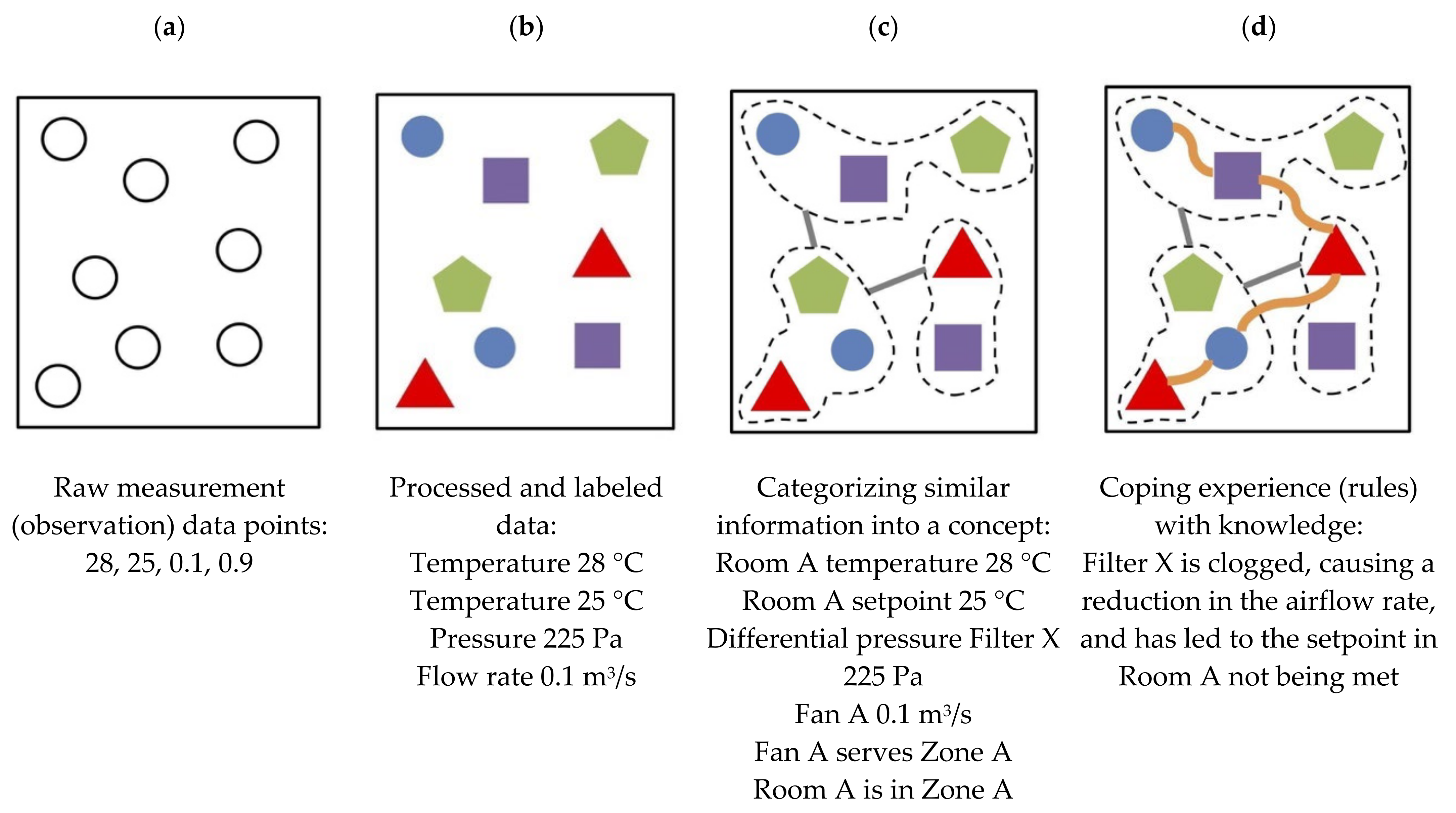
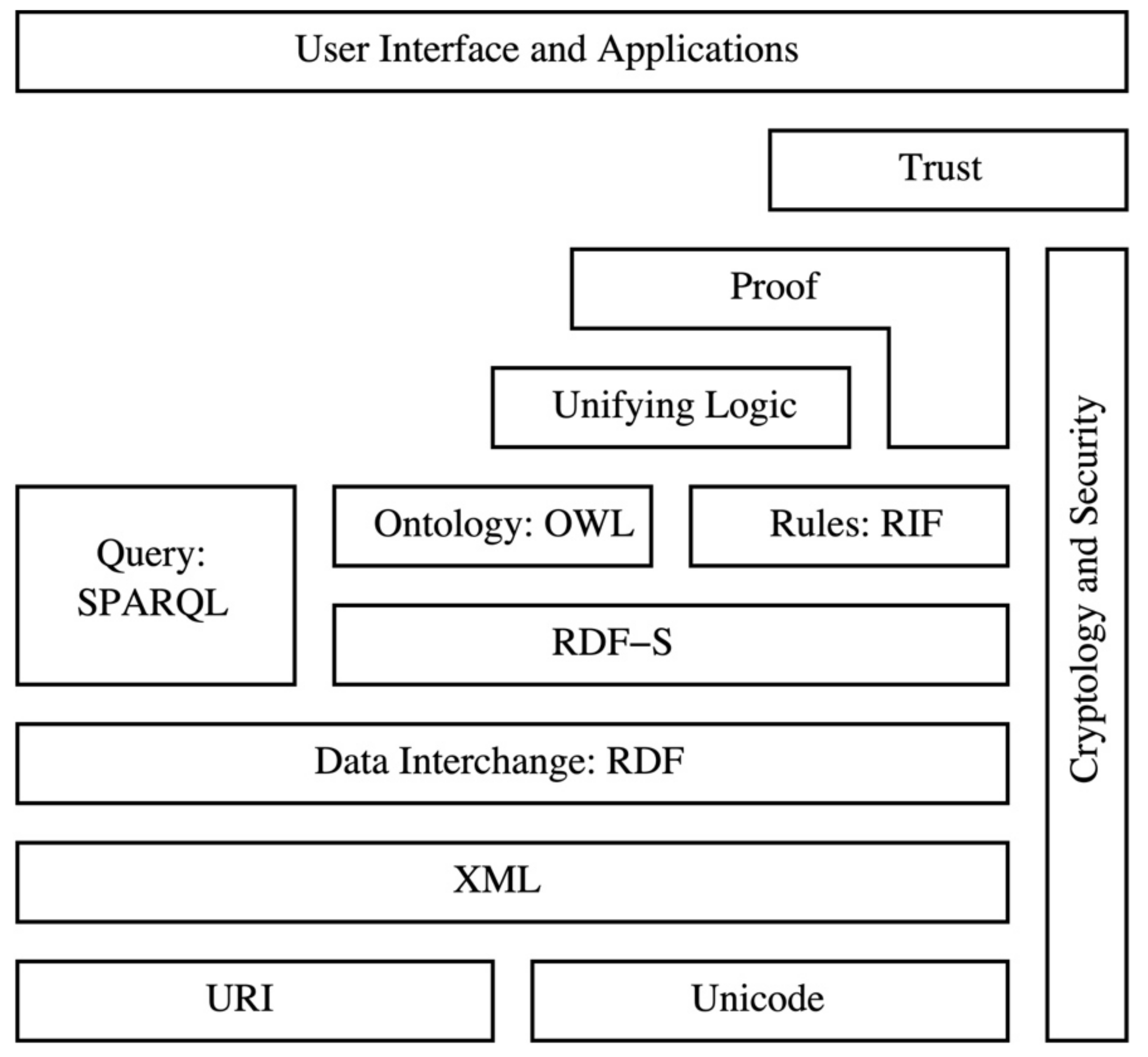
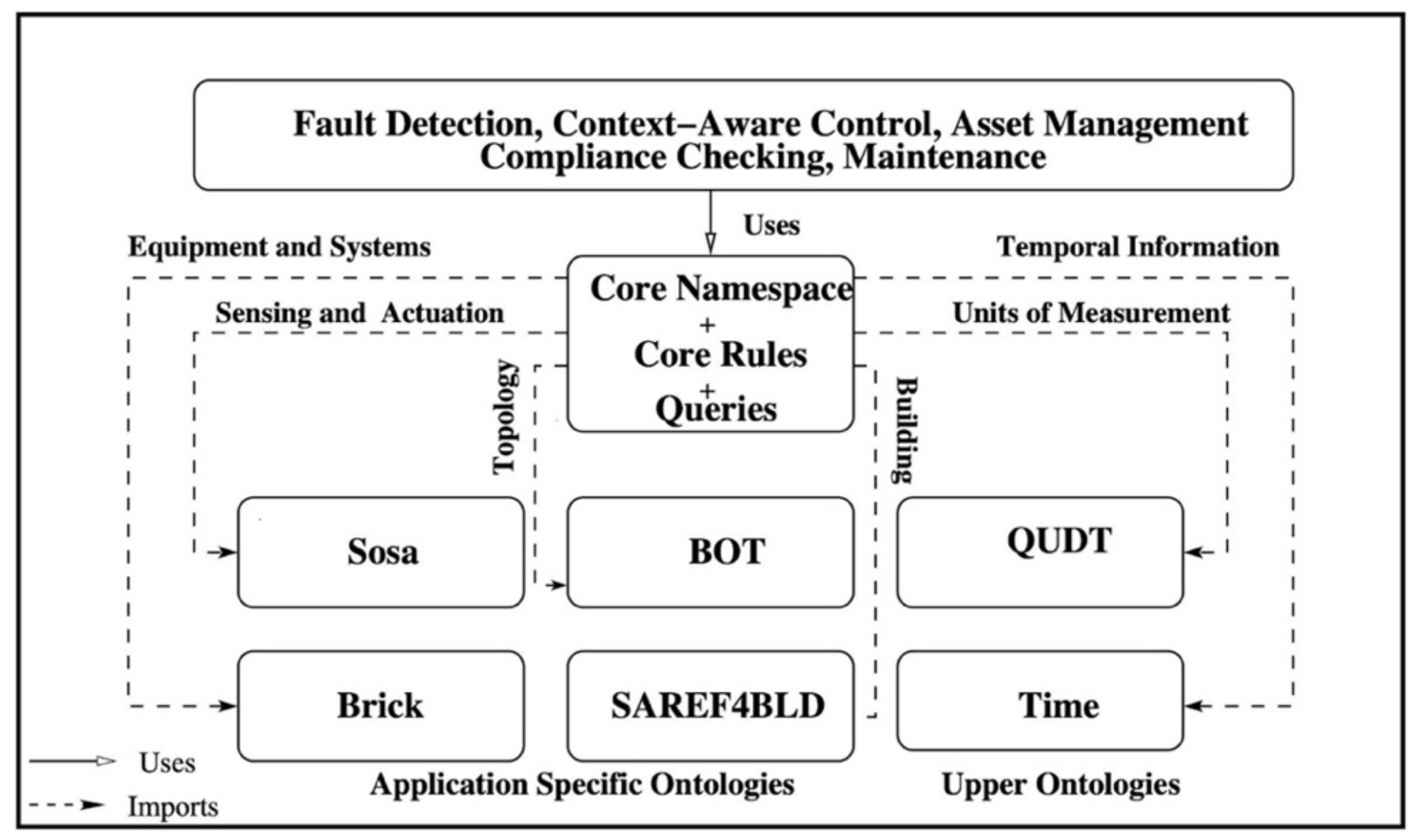
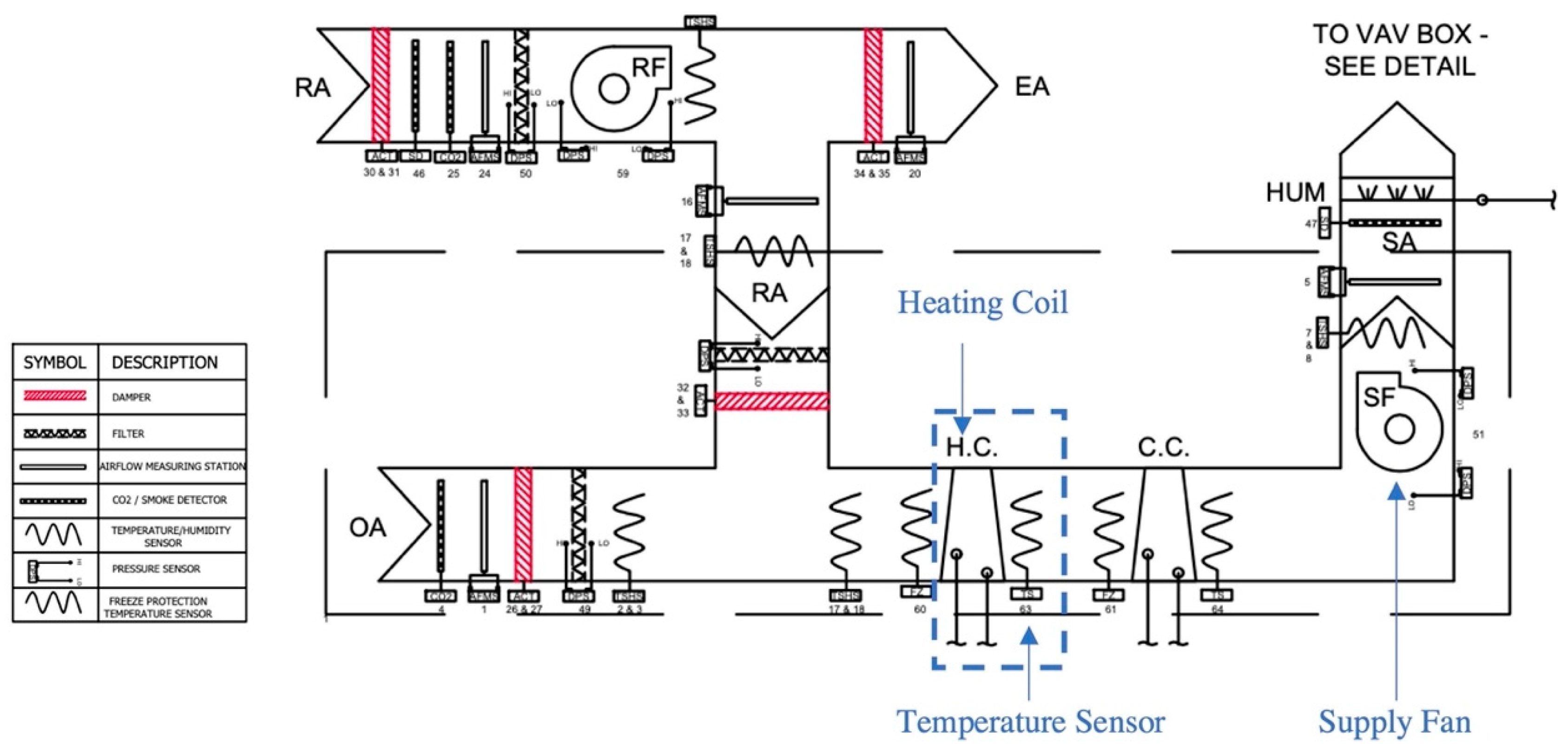
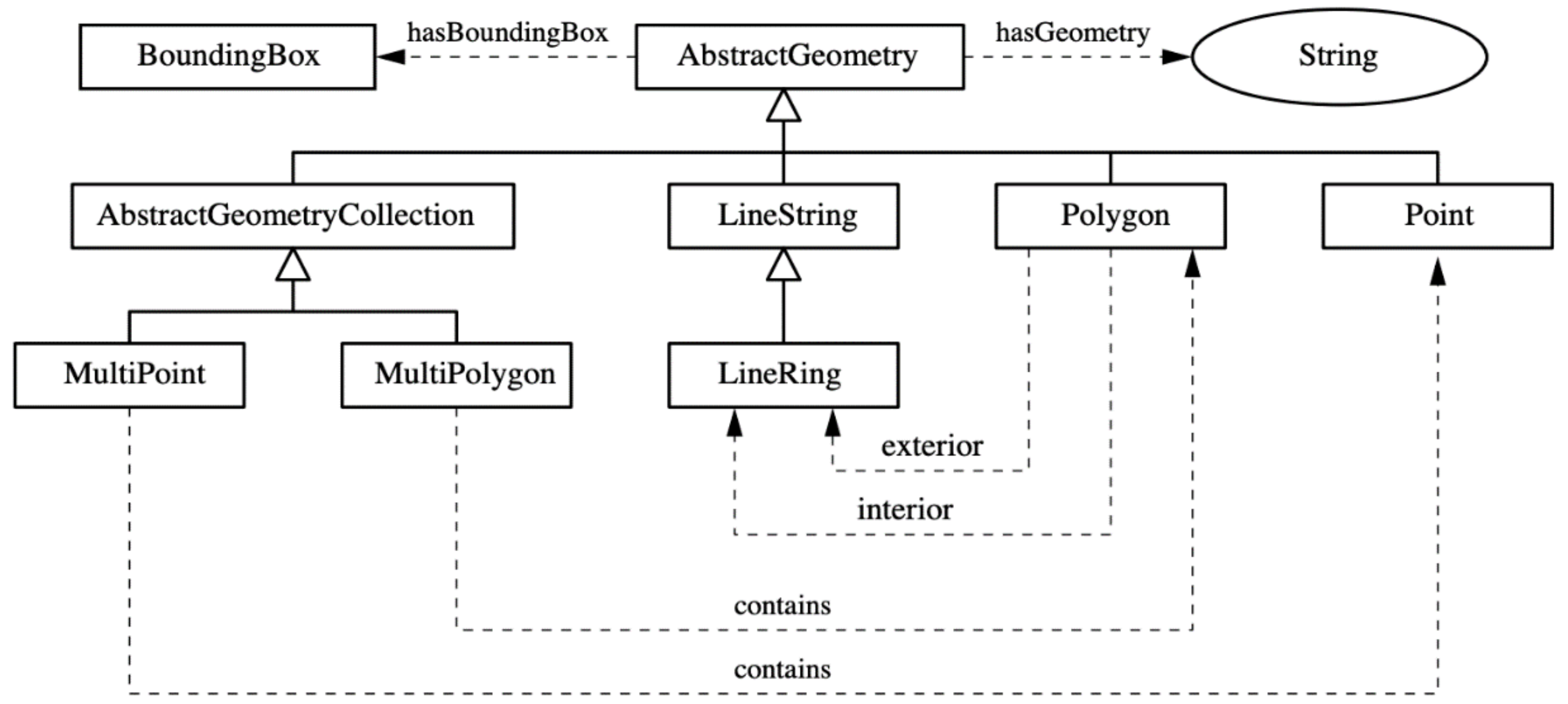
| Name | Ontology Description | URLs to the Ontologies |
|---|---|---|
| SAREF4BLDG | An ontology pattern for systems, connections and connection points | https://saref.etsi.org/saref4bldg (accessed on 1 November 2021) |
| RealEstateCore | An ontology for smart buildings, based on established practices in real estate | https://w3id.org/rec/full/ (accessed on 1 November 2021) |
| SOSA (Sensor Observation Sampling Actuation) | Semantic description of sensors and observations | https://www.w3.org/TR/vocab-ssn/ (accessed on 1 November 2021) |
| QUDT (Quantity, Unit, Datatype) | Semantic description of units of measure, quantity type, dimensions and data types | http://qudt.org/2.1/schema/qudt (accessed on 1 November 2021) |
| Brick Schema | Semantic description of physical, logical and virtual assets in buildings and the relationships between them | https://brickschema.org/schema/Brick (accessed on 1 November 2021) |
| BOT (Building Topology Ontology) | Semantic description of concepts in buildings such as sites, zones and rooms | https://w3c-lbd-cg.github.io/lbd/bot/ (accessed on 1 November 2021) |
| Time Ontology | Semantic description of time | https://www.w3.org/TR/owl-time (accessed on 1 November 2021) |
| @prefix ns: <http://example.org/ex#>. @prefix brick: <https://brickschema.org/schema/1.1/Brick#>. @prefix xs: <http://www.w3.org/2001/XMLSchema#>. @prefix rdf: <http://www.w3.org/1999/02/22-rdf-syntax-ns#>. // Definition of Supply Air Temperature Sensor [SupplyAir: (?ahu rdf:type brick:AHU)(?vav rdf:type brick:VAV)(?satv rdf:type ns:Air_Temperature_Sensor) (?sata rdf:type ns:Air_Temperature_Sensor) (?vav brick:hasPoint ?satv)(?ahu brick:hasPoint ?sata) equal(?satv,?sata)-> (?sata ns:isSupplyAir “true”^^xs:boolean) print(‘Supply temperature’, ?sata)] |
| SELECT ?downStream WHERE{ BIND(:heatingCoil1> AS ?d) { ?d s223:hasConnectionPoint ?cp1. ?cp1 a s223:OutletConnectionPoint. ?cp1 s223:connectsThrough ?downcon. ?downStream a s223:TempSensor. ?downStream s223:hasMeasurementLocation ?downcon. } Result: [downstream] ex:TemperatureSensor1 |
| ASK WHERE { ?d a:Coil. ?d:hasRole role:Cooling. ?d:connectedTo* ?fan. ?fan a:Fan. } Result: true | ASK WHERE { ?d a:Coil. ?d:hasRole role:Cooling. ?d:connectedFrom* ?fan. ?fan a:Fan. } Result: False |
| @prefix ns: <http://example.org/ex#>. @prefix sosa: <http://www.w3.org/ns/sosa#>. @prefix brick: <https://brickschema.org/schema/1.1/Brick#>. @prefix rdf: <http://www.w3.org/1999/02/22-rdf-syntax-ns#>. @prefix qudt: <http://qudt.org/1.1/schema/qudt#>. // Detect a cooling coil valve leak [(?ahu rdf:type brick:AHU) (?ahu brick:hasPoint ?v) (?ahu brick:hasPoint ?s1) (?ahu brick:hasPoint ?s2) (?v rdf:type brick:Cooling_Valve) (?v ns:isShutOff true) (?s1 rdf:type brick:Mixed_Air_Temperature_Sensor) (?s2 rdf:type brick:Supply_Air_Temperature_Sensor) (?s1 sosa:madeObservation?ob1) (?s2 sosa:madeObservation ?ob2) compare(?ob1,?ob2,?c) equal(?c,”2”^^xs:int) -> RaiseAlarm (”Alarm Valve is Leaking”) ] // Detect a faulty sensor [(?z sosa:isFeatureOfInterestOf ?ob)(?s rdf:type ns:Air_Temperature_Sensor) (?s ns:maxRange ?max) (?s sosa:madeObservation ?ob) (?ob sosa:resultTime ?t) (?ob sosa:hasResult ?r) (?r sosa:hasSimpleResult ?sr) (?r rdf:type qudt:Quantity) (?r qudt:unit ?u) equal(‘DEG_F’,?u) ge(?sr,?maxRange) -> RaiseAlarm (”Sensor Reading Greater than Maximum Possible Value”) ] |
| @prefix ns: <http://example.org/ex#>. @prefix brick: <https://brickschema.org/schema/1.1/Brick#>. @prefix bot: < http://www.w3id.org/bot/bot.ttl#>. @prefix rdf: <http://www.w3.org/1999/02/22-rdf-syntax-ns#>. @prefix s4bldg: <https://saref.etsi.org/saref4bldg/>. // Identify Adjacent Zones: [(?r1 rdf:type brick:HVAC_Zone) (?r1 ns:hasGeometry ?r1jts)(?r2 rdf:type brick:HVAC_Zone)(?r2 ns:hasGeometry ?r2jts) getAdjacency(?r2jts,?r1jts,?t) equal(?t,”true”^^xs:boolean) -> (?r1 bot:adjacentZone ?r2)] // Locate a Sensor in a Zone: [(?r1 rdf:type brick:HVAC_Zone) (?r1 ns:hasGeometry ?r1jts) (?satv rdf:type ns:Air_Temperature_Sensor)(?satv ns:hasGeometry ?sajts) getPointInPolygon(?sajts,?r1jts, ?t)-> (?satv s4bldg:isContainedIn ?r1)] |
| @prefix time: <https://www.w3.org/TR/owl-time#>. // When Two Intervals Meet [(?x rdf:type time:TimeInterval) (?y rdf:type time:TimeInterval) (?x time:endsAt ?t) (?y time:beginsAt ?t) ->(?x time:intMeets ?y) ] //When an Instant Falls in an Interval [isInInterval: (?x rdf:type time:Interval) (?y rdf:type time:Instant) (?x time:hasBeginning ?t1) (?x time:hasEnd ?t2) lessThan (?t1, ?t2) (?y time:inXSDDateTimeStamp ?t3) lessThan(?t1,?t3) greaterThan(?t2,?t3) -> (?y time:inside ?x) ] |
| @prefix ns: <http://example.org/ex#>. @prefix brick: <https://brickschema.org/schema/1.1/Brick#>. @prefix rdf: <http://www.w3.org/1999/02/22-rdf-syntax-ns#>. (?valve rdf:type brick:Valve) (?valve ns:hasReplacementTime ?rt1) (?valve ns:hasRunTime ?rt2) greaterThan(?rt2,?rt1) -> (?valve:dueForService true) |
| @prefix ns: <http://example.org/ex#>. @prefix brick: <https://brickschema.org/schema/1.1/Brick#>. @prefix rdf: <http://www.w3.org/1999/02/22-rdf-syntax-ns#>. @prefix s4bldg: <https://saref.etsi.org/saref4bldg/>. @prefix qudt: <http://www.ontology-of-units-of-measure.org/resource/om-2/partsPerMillion> // Utilize the Demand Control Ventilation (?s rdf:type s4bldg:BuildingSpace) (?ef rdf:type brick:Exhaust_Fan)(?ef brick:hasPoint ?exfc)(?s ns:usage “parking garage”) (?cs rdf:type ns:CO_Sensor)(?s s4bldg:contains ?ct) (?s sosa:madeObservation ?ob) (?ob sosa:hasResult ?r) (?r sosa:hasSimpleResult ?sr) (?r qudt:unit ?u) equal(‘ppm’,?u) ge(?sr,35) -> (?exft ns:hasValue 100) |
Publisher’s Note: MDPI stays neutral with regard to jurisdictional claims in published maps and institutional affiliations. |
© 2022 by the authors. Licensee MDPI, Basel, Switzerland. This article is an open access article distributed under the terms and conditions of the Creative Commons Attribution (CC BY) license (https://creativecommons.org/licenses/by/4.0/).
Share and Cite
Delgoshaei, P.; Heidarinejad, M.; Austin, M.A. A Semantic Approach for Building System Operations: Knowledge Representation and Reasoning. Sustainability 2022, 14, 5810. https://doi.org/10.3390/su14105810
Delgoshaei P, Heidarinejad M, Austin MA. A Semantic Approach for Building System Operations: Knowledge Representation and Reasoning. Sustainability. 2022; 14(10):5810. https://doi.org/10.3390/su14105810
Chicago/Turabian StyleDelgoshaei, Parastoo, Mohammad Heidarinejad, and Mark A. Austin. 2022. "A Semantic Approach for Building System Operations: Knowledge Representation and Reasoning" Sustainability 14, no. 10: 5810. https://doi.org/10.3390/su14105810
APA StyleDelgoshaei, P., Heidarinejad, M., & Austin, M. A. (2022). A Semantic Approach for Building System Operations: Knowledge Representation and Reasoning. Sustainability, 14(10), 5810. https://doi.org/10.3390/su14105810







